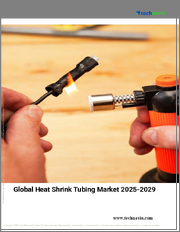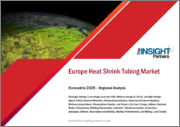
|
시장보고서
상품코드
1530750
열수축 튜브 시장 예측(-2030년) : 제품 유형별, 재료별, 정격전압별, 수축률별, 용도별, 최종사용자별, 지역별 세계 분석Heat-Shrink Tubing Market Forecasts to 2030 - Global Analysis By Product Type, Type, Material, Voltage Rating, Shrink Ratio, Application, End User and By Geography |
||||||
Stratistics MRC에 따르면 세계의 열수축 튜브 시장은 2024년에 25억 달러를 차지하고 예측 기간 중 CAGR은 6.8%로 성장하며, 2030년에는 37억 달러에 달할 전망입니다.
열수축 튜브는 열에 노출되면 수축하는 다용도 플라스틱 슬리브입니다. 열수축 튜브는 열에 노출되면 수축하는 다용도 플라스틱 슬리브로, 전기 및 전자 기기 용도에서 전선 및 케이블의 절연, 보호 및 정리를 위해 자주 사용되는 다용도 플라스틱 슬리브입니다. 열을 가하면 수축하여 밀폐된 부품 주변에 밀착된 보호 층을 형성하여 변형 완화, 내마모성 및 환경 보호 기능을 제공합니다. 또한 색상 구분 및 라벨링에도 유용합니다. 열수축 튜브는 산업계의 다양한 용도에 맞게 다양한 재질로 제공됩니다.
세계은행 보고서에 따르면 2030년까지 전 세계 인프라 투자는 연간 9조 4,000억 달러에 달할 것으로 예상됩니다. 전력망과 통신망을 포함한 인프라 프로젝트에 대한 이러한 대규모 투자는 케이블 보호 및 절연용 열수축 튜브에 대한 수요를 증가시킬 것으로 예상됩니다.
인프라 투자 확대
인프라 투자 확대는 절연 및 보호가 필요한 전기 및 전자 부품에 대한 수요를 증가시켜 열수축 튜브 시장을 촉진할 것입니다. 특히 신흥 국가에서는 인프라 프로젝트가 확대됨에 따라 신뢰할 수 있고 내구성이 뛰어난 배선 솔루션에 대한 수요가 증가하고 있습니다. 열수축 튜브는 전기 연결을 보호하고, 시스템 수명을 연장하고, 안전을 보장하는 데 필수적이어서 시장 성장을 촉진하고 있습니다.
원자재 가격 변동
원재료 가격의 변동은 열수축 튜브 제조업체에게 비용 측면에서 예측할 수 없는 요인이 되어 열수축 튜브 시장을 억제하는 요인으로 작용하고 있습니다. 폴리올레핀, 불소 수지 등 주요 원재료는 공급망 혼란과 원유 가격 변동으로 인해 가격이 불안정합니다. 이는 생산 비용과 이윤율에 영향을 미쳐 제품 가격 상승과 시장 경쟁력 저하로 이어질 수 있습니다.
신소재 개발
고분자 과학의 혁신은 더 튼튼하고 유연하며 환경 친화적인 소재의 탄생으로 이어지고 있습니다. 이러한 발전은 내열성, 내화학성, 전기 절연성 등의 특성이 개선된 열수축 튜브를 만들 수 있습니다. 바이오 및 재활용 가능한 재료의 도입은 지속가능성 증가 추세와 일치하며, 열수축 튜브 제품의 새로운 시장 분야와 용도를 개척할 수 있는 잠재력을 가지고 있습니다.
위조
위조품은 열수축 튜브 시장에 심각한 위협이 되고 있습니다. 저품질의 위조품이 유통되면 소비자의 신뢰를 훼손하고 브랜드 평판을 떨어뜨립니다. 이러한 위조품은 안전 기준과 성능 요구 사항을 충족하지 못하는 경우가 많아 장비 고장과 안전 위험을 초래할 수 있습니다. 이러한 위협은 시장 리더의 매출에 영향을 미칠 뿐만 아니라 중요한 용도에서 제품의 신뢰성에 대한 우려를 불러일으킵니다.
COVID-19의 영향 :
COVID-19 팬데믹은 초기에는 공급망 중단과 산업 활동 감소로 인해 열수축 튜브 시장을 혼란에 빠뜨렸습니다. 그러나 의료 인프라에 대한 관심이 높아지고 원격 근무 및 통신을 위한 전자 장비에 대한 수요가 급증하면서 이러한 부정적인 영향은 부분적으로 상쇄되었습니다. 또한 팬데믹은 산업 전반에 걸쳐 자동화 및 디지털화 도입을 가속화하여 시장의 장기적인 성장을 가속할 수 있습니다.
예측 기간 중 폴리올레핀 부문이 가장 클 것으로 예상됩니다.
폴리올레핀 부문은 다양한 용도에서 널리 사용되므로 열수축 튜브 시장을 지배할 것으로 예상됩니다. 폴리올레핀 튜브는 우수한 전기 절연 특성, 내화학성 및 비용 효율성으로 인해 선호되고 있습니다. 다용도한 특성으로 인해 자동차, 전기, 가전 산업 등에 적합합니다. 케이블, 전선 및 커넥터 절연에 광범위하게 사용되어 이 부문 시장 점유율을 크게 증가시켰습니다.
자동차 분야는 예측 기간 중 가장 높은 CAGR을 나타낼 것으로 예상됩니다.
열수축 튜브 시장은 자동차의 첨단 배선 솔루션에 대한 수요 증가로 인해 자동차 분야가 가장 높은 성장세를 보일 것으로 예상됩니다. 열수축 튜브는 자동차의 전기 시스템을 보호하고 절연하여 안전과 신뢰성을 보장하는 데 매우 중요합니다. 전기자동차(EV)의 보급과 첨단 전자 부품의 통합으로 인해 수요가 더욱 증가하여 이 분야의 성장을 가속하고 있습니다.
가장 큰 점유율을 차지하는 지역 :
아시아태평양은 열수축 튜브 시장을 독점하고 있습니다. 이러한 우위는 급속한 산업화, 광범위한 인프라 구축, 중국 및 인도와 같은 주요 제조 기지의 존재에 기인합니다. 이 지역에서는 자동차 및 전자 산업이 호황을 누리고 있으며, 발전 및 전력망에 대한 대규모 투자도 열수축 튜브에 대한 수요를 크게 견인하고 있습니다. 에너지 효율과 재생에너지 프로젝트를 추진하려는 정부의 구상도 시장 성장에 기여하고 있으며, 아시아태평양은 열수축 튜브 제품의 가장 큰 시장으로 자리매김하고 있습니다.
CAGR이 가장 높은 지역 :
아시아태평양은 열수축 튜브 시장의 급격한 성장이 예상되는 지역입니다. 이러한 높은 성장률의 배경에는 도시화, 전력 소비 증가, 신흥 경제국의 통신 네트워크 확장이 있습니다. 이 지역의 자동차 산업, 특히 전기자동차 생산은 빠르게 성장하고 있으며, 이는 열수축 튜브 용도에 새로운 비즈니스 기회를 제공합니다. 또한 첨단 제조 산업으로의 전환과 인더스트리 4.0의 도입은 첨단 전선 및 케이블 보호 솔루션에 대한 수요를 촉진하여 이 지역 시장 성장 가속화에 기여하고 있습니다.
무료 커스터마이즈 서비스 :
본 리포트를 구독하는 고객은 아래의 무료 커스터마이즈 옵션 중 하나를 이용할 수 있습니다. :
- 기업 개요
- 추가 시장 기업의 종합적 프로파일링(최대 3사)
- 주요 기업의 SWOT 분석(최대 3사)
- 지역 세분화
- 고객의 관심에 따른 주요 국가의 시장 추산·예측·CAGR(주 : 타당성 확인에 따라 다름)
- 경쟁 벤치마킹
- 제품 포트폴리오, 지역적 프레즌스, 전략적 제휴에 기반한 주요 기업의 벤치마킹
목차
제1장 개요
제2장 서문
- 개요
- 이해관계자
- 조사 범위
- 조사 방법
- 데이터 마이닝
- 데이터 분석
- 데이터 검증
- 조사 어프로치
- 조사 정보원
- 1차 조사 정보원
- 2차 조사 정보원
- 전제조건
제3장 시장 동향 분석
- 촉진요인
- 억제요인
- 기회
- 위협
- 제품 분석
- 용도 분석
- 최종사용자 분석
- 신흥 시장
- COVID-19의 영향
제4장 Porter's Five Forces 분석
- 공급 기업의 교섭력
- 바이어의 교섭력
- 대체품의 위협
- 신규 진출업체의 위협
- 경쟁 기업 간 경쟁 관계
제5장 세계의 열수축 튜브 시장 : 제품 유형별
- 스풀
- 프리컷 길이
- 기타 제품 유형
제6장 세계의 열수축 튜브 시장 : 유형별
- 싱글 월
- 듀얼 월
제7장 세계의 열수축 튜브 시장 : 재료별
- 폴리올레핀
- 폴리테트라플루오로에틸렌(PTFE)
- 불소화 에틸렌 프로필렌(FEP)
- PFA(Perfluoroalkoxy Alkane)
- PVDF(Polyvinylidene Fluoride)
- 폴리에테르 에테르 케톤(PEEK)
- 기타 재료
제8장 세계의 열수축 튜브 시장 : 전압 정격별
- 저전압
- 중전압
- 고전압
제9장 세계의 열수축 튜브 시장 : 수축률별
- 2 : 1 수축률
- 3 : 1 수축률
- 4 : 1 수축률
- 기타 수축률
제10장 세계의 열수축 튜브 시장 : 용도별
- 전기 절연과 보호
- 기계적 보호와 장력 완화
- 케이블 번들링과 식별
- 환경 실과 부식 방지
- 기타 용도
제11장 세계의 열수축 튜브 시장 : 최종사용자별
- 에너지와 유틸리티
- 항공우주와 방위
- 자동차
- 화학제품
- 건설
- 전기·전자
- 식품 및 음료
- 헬스케어
- 석유 및 가스
- 통신
- 기타 최종사용자
제12장 세계의 열수축 튜브 시장 : 지역별
- 북미
- 미국
- 캐나다
- 멕시코
- 유럽
- 독일
- 영국
- 이탈리아
- 프랑스
- 스페인
- 기타 유럽
- 아시아태평양
- 일본
- 중국
- 인도
- 호주
- 뉴질랜드
- 한국
- 기타 아시아태평양
- 남미
- 아르헨티나
- 브라질
- 칠레
- 기타 남미
- 중동 및 아프리카
- 사우디아라비아
- 아랍에미리트
- 카타르
- 남아프리카공화국
- 기타 중동 및 아프리카
제13장 주요 발전
- 계약, 파트너십, 협업, 합병사업
- 인수와 합병
- 신제품 발매
- 사업 확대
- 기타 주요 전략
제14장 기업 프로파일링
- TE Connectivity
- Sumitomo Electric Industries
- 3M Company
- HellermannTyton
- Alpha Wire
- Panduit
- Qualtek Electronics Corp.
- Zeus Industrial Products
- Insultab
- DSG-Canusa
- Koch Industries
- Changyuan Group Limited
- Woer
- Lubrizol Corporation
- Wuxi Dr. Heat Shrink Tubing Co., Ltd.
- SAB S.p.A.
- Dasheng Heat Shrinkable Material Co., Ltd.
- Nexans
According to Stratistics MRC, the Global Heat-Shrink Tubing Market is accounted for $2.5 billion in 2024 and is expected to reach $3.7 billion by 2030 growing at a CAGR of 6.8% during the forecast period. Heat-shrink tubing is a versatile plastic sleeve that contracts when exposed to heat. It's commonly used in electrical and electronic applications for insulation, protection, and organization of wires and cables. When heated, the tubing shrinks to form a tight, protective layer around the enclosed components, providing strain relief, abrasion resistance, and environmental protection. It also helps with color-coding and labeling. Heat-shrink tubing is available in various materials to suit different applications in industries.
According to a report by the World Bank, global infrastructure investment is expected to reach $9.4 trillion annually by 2030. This significant investment in infrastructure projects, including power grids and telecommunications networks, will drive the demand for heat-shrink tubing for cable protection and insulation.
Market Dynamics:
Driver:
Growing infrastructure investment
Growing infrastructure investment drives the heat-shrink tubing market by increasing the demand for electrical and electronic components that require insulation and protection. As infrastructure projects expand, especially in emerging economies, the need for reliable and durable wiring solutions rises. Heat-shrink tubing is essential in safeguarding electrical connections, enhancing system longevity, and ensuring safety, thus boosting its market growth.
Restraint:
Fluctuating raw material prices
Fluctuating raw material prices act as a restraint in the heat-shrink tubing market by creating cost unpredictability for manufacturers. The primary materials, such as polyolefin and fluoropolymers, experience price volatility due to supply chain disruptions and varying crude oil prices. This impacts production costs and profit margins, potentially leading to higher product prices and reduced market competitivenes.
Opportunity:
Development of new materials
Innovations in polymer science are leading to the creation of more durable, flexible, and environmentally friendly materials. These advancements can result in heat-shrink tubing with enhanced properties such as higher temperature resistance, better chemical resistance, and improved electrical insulation. The introduction of bio-based and recyclable materials aligns with growing sustainability trends, potentially opening new market segments and applications for heat-shrink tubing products.
Threat:
Counterfeiting
Counterfeiting poses a serious threat to the heat-shrink tubing market. The presence of low-quality, fake products can undermine consumer trust and damage brand reputation. These counterfeit products often fail to meet safety standards and performance requirements, potentially leading to equipment failures or safety hazards. This threat not only impacts market leaders' revenue but also raises concerns about product reliability in critical applications.
Covid-19 Impact:
The COVID-19 pandemic initially disrupted the heat-shrink tubing market due to supply chain interruptions and reduced industrial activity. However, the increased focus on healthcare infrastructure and the surge in demand for electronic devices for remote work and communication have partially offset these negative impacts. The pandemic has also accelerated the adoption of automation and digitalization across industries, potentially driving long-term growth in the market.
The polyolefin segment is expected to be the largest during the forecast period
The Polyolefin segment is expected to dominate the heat-shrink tubing market due to its widespread use in various applications. Polyolefin tubing is favored for its excellent electrical insulation properties, chemical resistance, and cost-effectiveness. Its versatility makes it suitable for automotive, electrical, and consumer electronics industries. The segment's extensive use in insulating cables, wires, and connectors drives its substantial market share.
The automotive segment is expected to have the highest CAGR during the forecast period
The Automotive segment is projected to experience the highest growth in the heat-shrink tubing market due to the increasing demand for advanced wiring solutions in vehicles. Heat-shrink tubing is crucial for protecting and insulating automotive electrical systems, ensuring safety and reliability. The growing adoption of electric vehicles (EVs) and the integration of sophisticated electronic components further drive the demand, boosting the segment's growth.
Region with largest share:
The Asia Pacific region is positioned to dominate the Heat-Shrink Tubing Market. This dominance is attributed to rapid industrialization, extensive infrastructure development, and the presence of major manufacturing hubs in countries like China and India. The region's booming automotive and electronics industries, coupled with significant investments in power generation and distribution networks, drive substantial demand for heat-shrink tubing. Government initiatives promoting energy efficiency and renewable energy projects further contribute to market growth, solidifying Asia Pacific's position as the largest market for heat-shrink tubing products.
Region with highest CAGR:
The Asia Pacific region anticipates rapid growth in the Heat-Shrink Tubing Market. This high growth rate is fueled by ongoing urbanization, increasing electricity consumption, and the expansion of telecommunications networks across developing economies. The region's fast-growing automotive sector, particularly in electric vehicle production, is creating new opportunities for heat-shrink tubing applications. Additionally, the shift towards high-tech manufacturing and the adoption of Industry 4.0 practices are driving demand for advanced wire and cable protection solutions, contributing to the region's accelerated market growth.
Key players in the market
Some of the key players in Heat-Shrink Tubing market include TE Connectivity, Sumitomo Electric Industries, 3M Company, HellermannTyton, Alpha Wire, Panduit, Qualtek Electronics Corp., Zeus Industrial Products, Insultab, DSG-Canusa, Koch Industries, Changyuan Group Limited, Woer, Lubrizol Corporation, Wuxi Dr. Heat Shrink Tubing Co., Ltd., SAB S.p.A., Dasheng Heat Shrinkable Material Co., Ltd., and Nexans.
Key Developments:
In March 2024, Sumitomo Electric Industries, Ltd. presents the achievement of new silica glass optical fiber with an ultra-low loss of 0.1397 dB/km. This work has been accepted as a regular paper at the Optical Fiber Communication Conference (OFC) 2024 to be held in San Diego.
In January 2024, Panduit, a global leader in innovative electrical and network infrastructure solutions, announces it has successfully complied and received certification for its cable cleats in accordance with the recently published technical standard by the Canadian Standards Association (CSA). CSA C22.2 No.61914:23 Cable Cleats for Electrical Installations, was published in early October 2023. This achievement underscores the company's ongoing dedication to providing cutting-edge, safe, and reliable solutions to meet the ever-evolving demands of the industry.
In June 2022, Zeus, the global leader in advanced polymer solutions, announced a multi-million dollar investment to expand its catheter manufacturing capacity worldwide. The first phase of the expansion program is already underway at the company's San Jose location in California. This initial project will significantly extend the facility's footprint to increase catheter-based design and manufacturing capacity.
Product Types Covered:
- Spools
- Pre-Cut Length
- Other Product Types
Types Covered:
- Single Wall
- Dual Wall
Materials Covered:
- Polyolefin
- Polytetrafluoroethylene (PTFE)
- Fluorinated Ethylene Propylene (FEP)
- Perfluoroalkoxy Alkane (PFA)
- Polyvinylidene Fluoride (PVDF)
- Polyether Ether Ketone (PEEK)
- Other Materials
Voltage Ratings Covered:
- Low Voltage
- Medium Voltage
- High Voltage
Shrink Ratios Covered:
- 2:1 Shrink Ratio
- 3:1 Shrink Ratio
- 4:1 Shrink Ratio
- Other Shrink Ratios
Applications Covered:
- Electrical Insulation and Protection
- Mechanical Protection and Strain Relief
- Cable Bundling and Identification
- Environmental Sealing and Corrosion Protection
- Other Applications
End Users Covered:
- Energy and Utilities
- Aerospace and Defense
- Automotive
- Chemical
- Construction
- Electrical and Electronics
- Food and Beverage
- Healthcare
- Oil and Gas
- Telecommunications
- Other End Users
Regions Covered:
- North America
- US
- Canada
- Mexico
- Europe
- Germany
- UK
- Italy
- France
- Spain
- Rest of Europe
- Asia Pacific
- Japan
- China
- India
- Australia
- New Zealand
- South Korea
- Rest of Asia Pacific
- South America
- Argentina
- Brazil
- Chile
- Rest of South America
- Middle East & Africa
- Saudi Arabia
- UAE
- Qatar
- South Africa
- Rest of Middle East & Africa
What our report offers:
- Market share assessments for the regional and country-level segments
- Strategic recommendations for the new entrants
- Covers Market data for the years 2022, 2023, 2024, 2026, and 2030
- Market Trends (Drivers, Constraints, Opportunities, Threats, Challenges, Investment Opportunities, and recommendations)
- Strategic recommendations in key business segments based on the market estimations
- Competitive landscaping mapping the key common trends
- Company profiling with detailed strategies, financials, and recent developments
- Supply chain trends mapping the latest technological advancements
Free Customization Offerings:
All the customers of this report will be entitled to receive one of the following free customization options:
- Company Profiling
- Comprehensive profiling of additional market players (up to 3)
- SWOT Analysis of key players (up to 3)
- Regional Segmentation
- Market estimations, Forecasts and CAGR of any prominent country as per the client's interest (Note: Depends on feasibility check)
- Competitive Benchmarking
- Benchmarking of key players based on product portfolio, geographical presence, and strategic alliances
Table of Contents
1 Executive Summary
2 Preface
- 2.1 Abstract
- 2.2 Stake Holders
- 2.3 Research Scope
- 2.4 Research Methodology
- 2.4.1 Data Mining
- 2.4.2 Data Analysis
- 2.4.3 Data Validation
- 2.4.4 Research Approach
- 2.5 Research Sources
- 2.5.1 Primary Research Sources
- 2.5.2 Secondary Research Sources
- 2.5.3 Assumptions
3 Market Trend Analysis
- 3.1 Introduction
- 3.2 Drivers
- 3.3 Restraints
- 3.4 Opportunities
- 3.5 Threats
- 3.6 Product Analysis
- 3.7 Application Analysis
- 3.8 End User Analysis
- 3.9 Emerging Markets
- 3.10 Impact of Covid-19
4 Porters Five Force Analysis
- 4.1 Bargaining power of suppliers
- 4.2 Bargaining power of buyers
- 4.3 Threat of substitutes
- 4.4 Threat of new entrants
- 4.5 Competitive rivalry
5 Global Heat-Shrink Tubing Market, By Product Type
- 5.1 Introduction
- 5.2 Spools
- 5.3 Pre-Cut Length
- 5.4 Other Product Types
6 Global Heat-Shrink Tubing Market, By Type
- 6.1 Introduction
- 6.2 Single Wall
- 6.3 Dual Wall
7 Global Heat-Shrink Tubing Market, By Material
- 7.1 Introduction
- 7.2 Polyolefin
- 7.3 Polytetrafluoroethylene (PTFE)
- 7.4 Fluorinated Ethylene Propylene (FEP)
- 7.5 Perfluoroalkoxy Alkane (PFA)
- 7.6 Polyvinylidene Fluoride (PVDF)
- 7.7 Polyether Ether Ketone (PEEK)
- 7.8 Other Materials
8 Global Heat-Shrink Tubing Market, By Voltage Rating
- 8.1 Introduction
- 8.2 Low Voltage
- 8.3 Medium Voltage
- 8.4 High Voltage
9 Global Heat-Shrink Tubing Market, By Shrink Ratio
- 9.1 Introduction
- 9.2 2:1 Shrink Ratio
- 9.3 3:1 Shrink Ratio
- 9.4 4:1 Shrink Ratio
- 9.5 Other Shrink Ratios
10 Global Heat-Shrink Tubing Market, By Application
- 10.1 Introduction
- 10.2 Electrical Insulation and Protection
- 10.3 Mechanical Protection and Strain Relief
- 10.4 Cable Bundling and Identification
- 10.5 Environmental Sealing and Corrosion Protection
- 10.6 Other Applications
11 Global Heat-Shrink Tubing Market, By End User
- 11.1 Introduction
- 11.2 Energy and Utilities
- 11.3 Aerospace and Defense
- 11.4 Automotive
- 11.5 Chemical
- 11.6 Construction
- 11.7 Electrical and Electronics
- 11.8 Food and Beverage
- 11.9 Healthcare
- 11.10 Oil and Gas
- 11.11 Telecommunications
- 11.12 Other End Users
12 Global Heat-Shrink Tubing Market, By Geography
- 12.1 Introduction
- 12.2 North America
- 12.2.1 US
- 12.2.2 Canada
- 12.2.3 Mexico
- 12.3 Europe
- 12.3.1 Germany
- 12.3.2 UK
- 12.3.3 Italy
- 12.3.4 France
- 12.3.5 Spain
- 12.3.6 Rest of Europe
- 12.4 Asia Pacific
- 12.4.1 Japan
- 12.4.2 China
- 12.4.3 India
- 12.4.4 Australia
- 12.4.5 New Zealand
- 12.4.6 South Korea
- 12.4.7 Rest of Asia Pacific
- 12.5 South America
- 12.5.1 Argentina
- 12.5.2 Brazil
- 12.5.3 Chile
- 12.5.4 Rest of South America
- 12.6 Middle East & Africa
- 12.6.1 Saudi Arabia
- 12.6.2 UAE
- 12.6.3 Qatar
- 12.6.4 South Africa
- 12.6.5 Rest of Middle East & Africa
13 Key Developments
- 13.1 Agreements, Partnerships, Collaborations and Joint Ventures
- 13.2 Acquisitions & Mergers
- 13.3 New Product Launch
- 13.4 Expansions
- 13.5 Other Key Strategies
14 Company Profiling
- 14.1 TE Connectivity
- 14.2 Sumitomo Electric Industries
- 14.3 3M Company
- 14.4 HellermannTyton
- 14.5 Alpha Wire
- 14.6 Panduit
- 14.7 Qualtek Electronics Corp.
- 14.8 Zeus Industrial Products
- 14.9 Insultab
- 14.10 DSG-Canusa
- 14.11 Koch Industries
- 14.12 Changyuan Group Limited
- 14.13 Woer
- 14.14 Lubrizol Corporation
- 14.15 Wuxi Dr. Heat Shrink Tubing Co., Ltd.
- 14.16 SAB S.p.A.
- 14.17 Dasheng Heat Shrinkable Material Co., Ltd.
- 14.18 Nexans


















